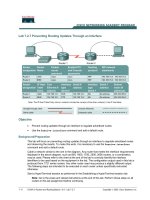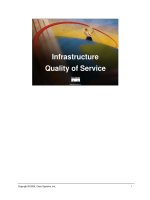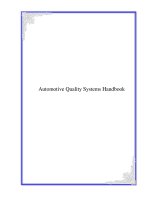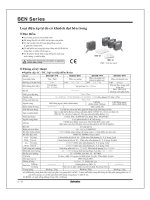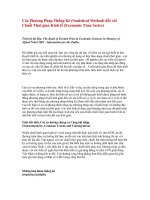Preventing Medication Errors: Quality Chasm Series ppt
Bạn đang xem bản rút gọn của tài liệu. Xem và tải ngay bản đầy đủ của tài liệu tại đây (1.71 MB, 481 trang )
Visit the
National Academies Press online, the authoritative source for all books
from the
National Academy of Sciences, the National Academy of Engineering,
the
Institute of Medicine, and the National Research Council:
• Download hundreds of free books in PDF
• Read thousands of books online for free
• Explore our innovative research tools – try the “Research Dashboard” now!
• Sign up to be notified when new books are published
• Purchase printed books and selected PDF files
Thank you for downloading this PDF. If you have comments, questions or
just want more information about the books published by the National
Academies Press, you may contact our customer service department toll-
free at 888-624-8373,
visit us online, or send an email to
This book plus thousands more are available at
.
Copyright © National Academy of Sciences. All rights reserved.
Unless otherwise indicated, all materials in this PDF File are copyrighted by the National
Academy of Sciences. Distribution, posting, or copying is strictly prohibited without
written permission of the National Academies Press.
Request reprint permission for this book.
ISBN: 0-309-65856-X, 480 pages, 6 x 9, (2007)
This PDF is available from the National Academies Press at:
/> />We ship printed books within 1 business day; personal PDFs are available immediately.
Preventing Medication Errors: Quality Chasm
Series
Committee on Identifying and Preventing Medication
Errors, Philip Aspden, Julie Wolcott, J. Lyle Bootman,
Linda R. Cronenwett, Editors
THE NATIONAL ACADEMIES PRESS
Washington, DC
www.nap.edu
Committee on Identifying and Preventing Medication Errors
Board on Health Care Services
Philip Aspden, Julie A. Wolcott, J. Lyle Bootman, Linda R. Cronenwett,
Editors
Preventing Medication Errors
Copyright © National Academy of Sciences. All rights reserved.
Preventing Medication Errors: Quality Chasm Series
/>THE NATIONAL ACADEMIES PRESS 500 Fifth Street, N.W. Washington, DC 20001
NOTICE: The project that is the subject of this report was approved by the Govern-
ing Board of the National Research Council, whose members are drawn from the
councils of the National Academy of Sciences, the National Academy of Engineer-
ing, and the Institute of Medicine. The members of the committee responsible for the
report were chosen for their special competences and with regard for appropriate
balance.
This study was supported by Contract No. HHSM-500-2004-00020C between the
National Academy of Sciences and Department of Health and Human Services (Cen-
ters for Medicare and Medicaid Services). Any opinions, findings, conclusions, or
recommendations expressed in this publication are those of the author(s) and do not
necessarily reflect the view of the organizations or agencies that provided support for
this project.
Library of Congress Cataloging-in-Publication Data
Preventing medication errors / Committee on Identifying and Preventing Medication
Errors, Board on Health Care Services ; Philip Aspden [et al.], editors.
p. ; cm. — (Quality chasm series)
Includes bibliographical references and index.
ISBN-13: 978-0-309-10147-9 (hardcover)
ISBN-10: 0-309-10147-6 (hardcover)
1. Medication errors—Prevention. I. Aspden, Philip. II. Institute of Medicine (U.S.).
Committee on Identifying and Preventing Medication Errors. III. Series.
[DNLM: 1. Medication Errors—prevention & control—United States. 2. Safety
Management—United States. QZ 42 P9435 2006]
RM146.P744 2006
615'.6—dc22
2006029215
Additional copies of this report are available from the National Academies Press,
500 Fifth Street, N.W., Lockbox 285, Washington, DC 20055; (800) 624-6242 or
(202) 334-3313 (in the Washington metropolitan area); Internet, http://www.
nap.edu.
For more information about the Institute of Medicine, visit the IOM home page at:
www.iom.edu.
Copyright 2007 by the National Academy of Sciences. All rights reserved.
Printed in the United States of America.
The serpent has been a symbol of long life, healing, and knowledge among almost all
cultures and religions since the beginning of recorded history. The serpent adopted
as a logotype by the Institute of Medicine is a relief carving from ancient Greece,
now held by the Staatliche Museen in Berlin.
Copyright © National Academy of Sciences. All rights reserved.
Preventing Medication Errors: Quality Chasm Series
/>“Knowing is not enough; we must apply.
Willing is not enough; we must do.”
—Goethe
Advising the Nation. Improving Health.
Copyright © National Academy of Sciences. All rights reserved.
Preventing Medication Errors: Quality Chasm Series
/>The National Academy of Sciences is a private, nonprofit, self-perpetuating society
of distinguished scholars engaged in scientific and engineering research, dedicated to
the furtherance of science and technology and to their use for the general welfare.
Upon the authority of the charter granted to it by the Congress in 1863, the Acad-
emy has a mandate that requires it to advise the federal government on scientific and
technical matters. Dr. Ralph J. Cicerone is president of the National Academy of
Sciences.
The National Academy of Engineering was established in 1964, under the charter of
the National Academy of Sciences, as a parallel organization of outstanding engi-
neers. It is autonomous in its administration and in the selection of its members,
sharing with the National Academy of Sciences the responsibility for advising the
federal government. The National Academy of Engineering also sponsors engineer-
ing programs aimed at meeting national needs, encourages education and research,
and recognizes the superior achievements of engineers. Dr. Wm. A. Wulf is president
of the National Academy of Engineering.
The Institute of Medicine was established in 1970 by the National Academy of Sci-
ences to secure the services of eminent members of appropriate professions in the
examination of policy matters pertaining to the health of the public. The Institute
acts under the responsibility given to the National Academy of Sciences by its con-
gressional charter to be an adviser to the federal government and, upon its own
initiative, to identify issues of medical care, research, and education. Dr. Harvey V.
Fineberg is president of the Institute of Medicine.
The National Research Council was organized by the National Academy of Sciences
in 1916 to associate the broad community of science and technology with the
Academy’s purposes of furthering knowledge and advising the federal government.
Functioning in accordance with general policies determined by the Academy, the
Council has become the principal operating agency of both the National Academy of
Sciences and the National Academy of Engineering in providing services to the gov-
ernment, the public, and the scientific and engineering communities. The Council is
administered jointly by both Academies and the Institute of Medicine. Dr. Ralph J.
Cicerone and Dr. Wm. A. Wulf are chair and vice chair, respectively, of the National
Research Council.
www.national-academies.org
Copyright © National Academy of Sciences. All rights reserved.
Preventing Medication Errors: Quality Chasm Series
/>v
COMMITTEE ON IDENTIFYING AND PREVENTING
MEDICATION ERRORS
J. LYLE BOOTMAN (Co-chair), Dean and Professor, University of
Arizona College of Pharmacy; Founding and Executive Director,
University of Arizona Center for Health Outcomes and
PharmacoEconomic (HOPE) Research
LINDA R. CRONENWETT (Co-chair), Professor and Dean, School of
Nursing, University of North Carolina at Chapel Hill
DAVID W. BATES, Chief, Division of General Medicine, Brigham and
Women’s Hospital; Medical Director of Clinical and Quality Analysis,
Partners Healthcare System; Professor of Medicine, Harvard Medical
School
ROBERT M. CALIFF, Associate Vice Chancellor for Clinical Research,
Director of the Duke Clinical Research Institute, and Professor of
Medicine, Division of Cardiology, Duke University Medical Center
H. ERIC CANNON, Director of Pharmacy Services and Health and
Wellness, IHC Health Plans, Intermountain Health Care
REBECCA W. CHATER, Director of Clinical Services, Kerr Drugs, Inc./
KDI Clinical Services
MICHAEL R. COHEN, President, Institute for Safe Medication Practices
JAMES B. CONWAY, Senior Fellow, Institute for Healthcare
Improvement; Senior Consultant, Dana-Farber Cancer Institute;
Adjunct Lecturer on Health Care Management, Department of Health
Policy and Management, Harvard School of Public Health
R. SCOTT EVANS, Senior Medical Informaticist, Department of Medical
Informatics, LDS Hospital and Intermountain Health Care; Professor,
Department of Medical Informatics, and Adjunct Professor,
Department of Medicine, University of Utah
ELIZABETH A. FLYNN, Associate Research Professor, Department of
Pharmacy Care Systems, Harrison School of Pharmacy, Auburn
University
JERRY H. GURWITZ, Chief, Division of Geriatric Medicine and Dr. John
Meyers Professor of Primary Care Medicine, University of
Massachusetts Medical School; and Executive Director, Meyers
Primary Care Institute, University of Massachusetts Medical School,
Fallon Foundation, and Fallon Community Health Plan
CHARLES B. INLANDER, Former President, People’s Medical Society
KEVIN B. JOHNSON, Associate Professor and Vice Chair, Department of
Biomedical Informatics, and Associate Professor, Department of
Pediatrics, Vanderbilt University Medical School
Copyright © National Academy of Sciences. All rights reserved.
Preventing Medication Errors: Quality Chasm Series
/>vi
WILSON D. PACE, Professor of Family Medicine and Green-Edelman
Chair for Practice-based Research, University of Colorado; Director,
American Academy of Family Physicians National Research Network
KATHLEEN R. STEVENS, Professor and Director, Academic Center for
Evidence-Based Practice, University of Texas Health Science Center,
San Antonio
EDWARD WESTRICK, Vice President of Medical Management,
University of Massachusetts Memorial Health Care
ALBERT W. WU, Professor of Health Policy and Management and
Internal Medicine, The Johns Hopkins University
Health Care Services Board
CLYDE J. BEHNEY, Acting Director (June 2005 to December 2005 and
from May 2006)
JOHN C. RING, Director (from December 2005 to May 2006)
JANET M. CORRIGAN, Director (September 2004 to May 2005)
ANTHONY BURTON, Administrative Assistant
Study Staff
PHILIP ASPDEN, Study Director
JULIE A. WOLCOTT, Program Officer (to April 2006)
ANDREA M. SCHULTZ, Research Associate (from June 2006)
RYAN L. PALUGOD, Research Assistant (from December 2005)
TASHARA BASTIEN, Senior Program Assistant (to January 2006)
WILLIAM B. MCLEOD, Senior Librarian
GARY J. WALKER, Senior Financial Officer (from December 2005)
TERESA REDD, Financial Advisor (to December 2005)
ELIZABETH E. LAFALCE, Intern (April to May, 2005)
Copyright © National Academy of Sciences. All rights reserved.
Preventing Medication Errors: Quality Chasm Series
/>vii
This report has been reviewed in draft form by individuals chosen for
their diverse perspectives and technical expertise, in accordance with proce-
dures approved by the NRC’s Report Review Committee. The purpose of
this independent review is to provide candid and critical comments that will
assist the institution in making its published report as sound as possible and
to ensure that the report meets institutional standards for objectivity, evi-
dence, and responsiveness to the study charge. The review comments and
draft manuscript remain confidential to protect the integrity of the delibera-
tive process. We wish to thank the following individuals for their review of
this report:
LOWELL ANDERSON, Watauga Corporation
MARGE BOWMAN, University of Pennsylvania Health System
PATRICIA FLATLEY BRENNAN, School of Nursing and College of
Engineering, University of Wisconsin-Madison
DAVID COUSINS, National Patient Safety Organization, London
DON E. DETMER, American Medical Informatics Association and
The University of Virginia
WILLIAM EVANS, St. Jude Children’s Research Hospital, Memphis
ANN HENDRICH, Ascension Health, St. Louis, MO
CRAIG HOESLEY, University Hospital, University of Alabama at
Birmingham
WILLIAM J. KOOPMAN, Department of Medicine, University of
Alabama at Birmingham
GERALD D. LAUBACH, Pfizer Inc., Past President
Reviewers
Copyright © National Academy of Sciences. All rights reserved.
Preventing Medication Errors: Quality Chasm Series
/>LUCIAN LEAPE, Department of Health Policy and Management,
Harvard School of Public Health
ART LEVIN, Center for Medical Consumers, New York, NY
G. STEVE REBAGLIATI, Department of Emergency Medicine, Oregon
Health and Sciences University
HUGH TILSON, School of Public Health, University of North Carolina
Although the reviewers listed above have provided many constructive
comments and suggestions, they were not asked to endorse the conclusions
or recommendations nor did they see the final draft of the report before its
release. The review of this report was overseen by Paul F. Griner, University
of Rochester, Professor Emeritus and Charles E. Phelps, University of Roch-
ester. Appointed by the National Research Council and Institute of Medi-
cine, they were responsible for making certain that an independent exami-
nation of this report was carried out in accordance with institutional
procedures and that all review comments were carefully considered. Re-
sponsibility for the final content of this report rests entirely with the author-
ing committee and the institution.
viii REVIEWERS
Copyright © National Academy of Sciences. All rights reserved.
Preventing Medication Errors: Quality Chasm Series
/>ix
In 2000, the Institute of Medicine (IOM) report To Err Is Human: Build-
ing a Safer Health System raised awareness about medical errors and accel-
erated existing efforts to prevent such errors. The present report makes clear
that with regard to medication errors, we still have a long way to go. The
current medication-use process, which encompasses prescribing, dispensing,
administering, and monitoring, is characterized by many serious problems
and issues that threaten both the safety and positive outcomes of the pro-
cess. Each of the steps in the process needs improvement and further study.
At the beginning of the medication-use process, prescribers often lack
sufficient knowledge about how the drugs they are prescribing will work in
specific patient populations. If the balance of medication risks and benefits
is not known (as is common, for example, with children and the elderly), it
is impossible to say whether medication use is safe. Improving medication
use and reducing errors, therefore, requires improving the quality of infor-
mation generated by the pharmaceutical industry and other researchers re-
garding drug products and their use in clinical practice. We also need to
better understand how to communicate such information to clinicians and
patients via packaging, leaflets, and health information technology systems.
Lastly, we need to understand how better to prevent medication errors in all
care settings and in transitions between care settings. In this report, the IOM
Committee on Identifying and Preventing Medication Errors proposes a re-
search agenda for industry and government that can help meet these critical
needs.
Despite the lack of data regarding many interventions that might im-
prove the quality and safety of medication use, the committee offers recom-
Preface
Copyright © National Academy of Sciences. All rights reserved.
Preventing Medication Errors: Quality Chasm Series
/>x PREFACE
mendations for change that should be implemented and evaluated. People
who use medications to meet their health care needs have a huge stake in
that effort. The most powerful strategy for improving safety may be moti-
vating providers and organizations to support the full engagement of pa-
tients and surrogates in improving the safety of medication use. In addition,
providers and leaders of health care organizations must create the climate
and infrastructure necessary to continuously learn about and improve the
safety of all steps in the medication-use process. This report provides guid-
ance on the types of error prevention strategies that should be implemented
in each care setting. It also presents the committee’s recommendations for
the pharmaceutical industry, government, and regulatory, certification, and
accreditation bodies, each of which has a role to play in improving the qual-
ity and safety of medication use.
This report represents the culmination of the dedicated efforts of three
groups of people. We would like to thank our fellow committee members
who have worked long and diligently on this challenging study, the many
experts who provided formal testimony to the committee and informal ad-
vice throughout the study, and the staff of the Health Care Services Board
who managed the study and coordinated the writing of the final report.
J. Lyle Bootman, Ph.D., Sc.D.
Linda R. Cronenwett, Ph.D., M.A., R.N.
Cochairs
July 2006
Copyright © National Academy of Sciences. All rights reserved.
Preventing Medication Errors: Quality Chasm Series
/>xi
The Committee on Identifying and Preventing Medication Errors wishes
to acknowledge the many people whose contributions and support made
this report possible. The committee benefited from presentations made by a
number of experts over the past 2 years. The following individuals shared
their research, experience, and perspectives with the committee: Tom
Abrams, Food and Drug Administration; Bruce Bagley, American Academy
of Family Physicians; Robert Ball, Food and Drug Administration; Jim
Battles, Agency for Healthcare Research and Quality; Karen Bell, Centers
for Medicare and Medicaid Services; Douglas Bierer, Consumer Healthcare
Products Association; David Bowen, Office of Senator Edward Kennedy;
Bill Braithwaite, eHealth Initiative; Dan Budnitz, Centers for Disease Con-
trol and Prevention; Betsy Chrischilles, University of Iowa; John Clarke,
ECRI; David Classen, First Consulting Group; Ilene Corina, Patients United
Limiting Substandards and Errors in Healthcare; Diane Cousins, U.S.
Pharmacopeial Convention; Loriann De Martini, California Department of
Health Services; Noel Eldridge, Veterans Health Administration; Frank
Federico, Institute for Healthcare Improvement; Susan Frampton, Planetree;
David Gustafson, University of Wisconsin; Ed Hammond, Duke University;
Mark Hayes, Office of Senator Chuck Grassley; Carol Holquist, Food and
Drug Administration; David Hunt, Centers for Medicare and Medicaid Ser-
vices; Gordon Hunt, Sutter Health; John Jenkins, Food and Drug Adminis-
tration; Mike Kafrissen, Johnson & Johnson; Ken Kizer, National Quality
Forum; Richard Moore, Massachusetts State Senator; Bill Munier, Agency
for Healthcare Research and Quality; Dianne Murphy, Food and Drug Ad-
ministration; Steve Northrop, Office of Senator Chuck Grassley; Jerry
Acknowledgments
Copyright © National Academy of Sciences. All rights reserved.
Preventing Medication Errors: Quality Chasm Series
/>xii ACKNOWLEDGMENTS
Osheroff, Micromedex; Emily Patterson, Ohio State University; John
Reiling, Synergy Health and St. Joseph’s Hospital; Lisa Robin, Federation of
State Medical Boards; William Rollow, Centers for Medicare and Medicaid
Services; Jeffrey Rothschild, Brigham and Women’s Hospital Partners
Healthcare; Lee Rucker, American Association of Retired Persons; Luke
Sato, Harvard Risk Management Foundation; Stephen Schondelmeyer, Uni-
versity of Minnesota; David Schulke, American Health Quality Association;
Paul Schyve, Joint Commission on Accreditation of Healthcare Organiza-
tions; Paul Seligman, Food and Drug Administration; Vickie Sheets, Na-
tional Council of State Boards of Nursing; Pat Sodomka, Medical College of
Georgia; Scott Stanley, University Health System Consortium; Jonathan
Teich, Health Vision; Anne Trontell, Food and Drug Administration; Tim
Vanderveen, Alaris & Cardinal Health; and Ed Weisbart, Express Scripts.
The following individuals were important sources of information, gen-
erously giving their time and knowledge to further the committee’s efforts:
Michele Boisse, American Society for Clinical Pharmacology and Therapeu-
tics; Anne Burns, American Pharmacists Association; Francis Dobscha, Ad-
vance Med; Melody Eble, Johnson & Johnson; Atheer Kaddis, Blue Cross
and Blue Shield of Michigan; Lucinda Maine, American Association of Col-
leges of Pharmacy; Gary Merica, York Hospital; Joseph Morris, Health Care
Improvement Foundation; Richard Park, IVD Technology magazine; Ken
Reid, Washington Information Source Co.; Ed Staffa, National Association
of Chain Drug Stores; Kasey Thompson, American Society of Health-system
Pharmacists; Marissa Schlaifer, Academy of Managed Care Pharmacy;
Junelle Speller, American Academy of Pediatrics; Sharon Wilson, Center for
Nursing Practice; and Charles Young, Massachusetts Board of Registration
in Pharmacy.
The committee commissioned eight papers that provided important
background information for the report, and would like to thank all the
authors for their dedicated work and helpful insights: Harvey J. Murff,
Vanderbilt University; Ginette A. Pepper, University of Utah College of Nurs-
ing; Grace M. Kuo, Baylor College of Medicine; Marlene R. Miller, Karen
A. Robinson, Lisa H. Lubomski, Michael L. Rinke, and Peter J Pronovost,
The Johns Hopkins University; Benjamin C. Grasso, The Institute for Self-
Directed Care; Albert I. Wertheimer and Thomas M. Santella, Temple Uni-
versity; Eta Berner, University of Alabama at Birmingham with assistance
from Lorri Zipperer, Zipperer Project Management; Richard Maisiak, con-
sultant; and Brent Petty, The Johns Hopkins University.
The committee also benefited from the work of other committees and
staff of the Institute of Medicine that conducted studies relevant to this
report, particularly the Committee on Quality of Health Care in America
and the Committee on Identifying Priority Areas for Quality Improvement.
The Committee on Quality of Health Care in America produced the 2000
Copyright © National Academy of Sciences. All rights reserved.
Preventing Medication Errors: Quality Chasm Series
/>ACKNOWLEDGMENTS xiii
report To Err Is Human: Building a Safer Health System and the 2001 re-
port Crossing the Quality Chasm: A New Health System for the 21st Cen-
tury. The committee on Identifying Priority Areas for Quality Improvement
produced the 2003 report Priority Areas for National Action: Transforming
Health Care Quality.
Finally, funding for this project was provided by the Centers for Medi-
care and Medicaid Services. The committee extends special thanks for that
support.
Copyright © National Academy of Sciences. All rights reserved.
Preventing Medication Errors: Quality Chasm Series
/>Copyright © National Academy of Sciences. All rights reserved.
Preventing Medication Errors: Quality Chasm Series
/>xv
Contents
SUMMARY 1
1 INTRODUCTION 25
PART I: UNDERSTANDING THE CAUSES AND COSTS OF
MEDICATION ERRORS 43
2 OVERVIEW OF THE DRUG DEVELOPMENT, REGULATION,
DISTRIBUTION, AND USE SYSTEM 50
3 MEDICATION ERRORS: INCIDENCE AND COST 105
PART II: MOVING TOWARD A PATIENT-CENTERED,
INTEGRATED MEDICATION-USE SYSTEM 143
4 ACTION AGENDA TO SUPPORT CONSUMER–PROVIDER
PARTNERSHIP 151
5 ACTION AGENDA FOR HEALTH CARE ORGANIZATIONS 221
6 ACTION AGENDA FOR THE PHARMACEUTICAL, MEDICAL
DEVICE, AND HEALTH INFORMATION TECHNOLOGY
INDUSTRIES 266
7 APPLIED RESEARCH AGENDA FOR SAFE MEDICATION
USE 310
8 ACTION AGENDAS FOR OVERSIGHT, REGULATION, AND
PAYMENT 328
Copyright © National Academy of Sciences. All rights reserved.
Preventing Medication Errors: Quality Chasm Series
/>xvi CONTENTS
APPENDIXES
A BIOGRAPHICAL SKETCHES OF COMMITTEE MEMBERS 349
B GLOSSARY OF TERMS AND ACRONYMS 359
C MEDICATION ERRORS: INCIDENCE RATES 367
D MEDICATION ERRORS: PREVENTION STRATEGIES 409
INDEX 447
Copyright © National Academy of Sciences. All rights reserved.
Preventing Medication Errors: Quality Chasm Series
/>1
Summary
ABSTRACT
The use of medications is ubiquitous. In any given week, more
than four of five U.S. adults take at least one medication (prescrip-
tion or over-the-counter [OTC] drug, vitamin/mineral, or herbal
supplement), and almost a third take at least five different medica-
tions.
1
Errors can occur with any of these products at any point in
the medication-use process and in any care setting. The frequency
of medication errors and preventable medication-related injuries
represents a very serious cause for concern.
The Centers for Medicare and Medicaid Services sponsored
this study by the Institute of Medicine (IOM) with the aim of
developing a national agenda for reducing medication errors based
on estimates of the incidence of such errors and evidence on the
efficacy of various prevention strategies. The study focused on the
safe, effective, and appropriate use of medications in the major
components of the medication-use system, addressing the use of
prescription drugs, OTC drugs, and complementary and alterna-
tive medications, in a wide range of care settings—hospital, long-
term, and community.
The committee estimates that on average, a hospital patient is
subject to at least one medication error per day, with considerable
1
In this report, the terms medication and drug are used interchangeably.
Copyright © National Academy of Sciences. All rights reserved.
Preventing Medication Errors: Quality Chasm Series
/>2 PREVENTING MEDICATION ERRORS
variation in error rates across facilities. The few existing studies of
the costs associated with medication errors are limited to the health
care costs incurred by preventable injuries, and these are substantial.
At least a quarter of all medication-related injuries are prevent-
able. Many efficacious error prevention strategies are available,
especially for hospital care; examples are electronic prescribing and
clinical decision-support systems that check dosages and monitor
for harmful drug–drug interactions. This report provides guidance
on how to implement error prevention strategies in hospitals, long-
term care, and ambulatory care.
Establishing and maintaining a strong provider–patient part-
nership is a key approach for reducing medication errors. The
report outlines how such a partnership can be achieved and what
roles providers, patients, and third parties must play. For example,
consumers should maintain careful records of their medications,
providers should review a patient’s list of medications at each en-
counter and at times of transition between care settings (e.g., hospi-
tal to outpatient care), and the federal government should seek
ways to improve the quality of pharmacy leaflets and medication-
related information on the Internet for consumers.
Health care providers in all settings should seek to create high-
reliability organizations that constantly improve the safety and
quality of medication use. To this end, they should implement
active internal monitoring programs so that progress toward im-
proved medication safety can be accurately demonstrated. The re-
port offers guidance on appropriate monitoring systems for each
major care setting.
In carrying out this study, the IOM committee identified enor-
mous gaps in the knowledge base with regard to medication errors.
Current methods for generating and communicating information
about medications are inadequate and contribute to the incidence
of errors. Likewise, incidence rates of medication errors in many
care settings, the costs of such errors, and the efficacy of prevention
strategies are not well understood. The report proposes a research
agenda to address these and other knowledge gaps.
STUDY SCOPE
The Institute of Medicine (IOM) report To Err Is Human: Building a
Safer Health System (IOM, 2000) accelerated existing efforts to prevent
medication errors and improve the quality of health care, efforts that are just
now gaining acceptance as a discipline requiring investment in individuals
who specialize in error prevention and quality improvement. Against this
background, at the urging of the Senate Finance Committee, the United States
Copyright © National Academy of Sciences. All rights reserved.
Preventing Medication Errors: Quality Chasm Series
/>SUMMARY 3
Congress directed the Centers for Medicare and Medicaid Services (CMS) to
contract with the IOM for a study to formulate a national agenda for reduc-
ing medication errors by developing estimates of the incidence of such errors
and determining the efficacy of prevention strategies (see Box S-1).
THE LEVEL AND CONSEQUENCES OF MEDICATION ERRORS
ARE UNACCEPTABLE
Rates of Errors and Preventable Harmful Events Are High
The frequency of medication errors and preventable adverse drug
events (ADEs) (defined in Box S-2) is a very serious cause for concern. In
BOX S-1
Scope of the Study
Congress, through the Medicare Modernization Act of 2003 (Section 107(c)),
mandated the Centers for Medicare and Medicaid Services to sponsor the Institute
of Medicine to carry out a study:
• To develop a fuller understanding of drug safety and quality issues through
the conduct of an evidence-based review of the literature, case studies and anal-
ysis. This review will consider the nature and causes of medication errors; their
impact on patients; and the differences in causation, impact and prevention across
multiple dimensions of health care delivery including patient populations, care set-
tings, clinicians, and institutional cultures.
• If possible, to develop estimates of the incidence, severity and costs of
medication errors that can be useful in prioritizing resources for national quality
improvement efforts and influencing national health care policy.
• To evaluate alternative approaches to reducing medication errors in terms
of their efficacy, cost-effectiveness, appropriateness in different settings and cir-
cumstances, feasibility, institutional barriers to implementation, associated risk,
and quality of evidence supporting the approach.
• To provide guidance to consumers, providers, payers, and other key stake-
holders on high-priority strategies to achieve both short-term and long-term drug
safety goals, to elucidate the goals and expected results of such initiatives and
support the business case for them, and to identify critical success factors and key
levers for achieving success.
• To assess opportunities and key impediments to broad nationwide imple-
mentation of medication error reductions, and to provide guidance to policy-
makers and government agencies in promoting a national agenda for medication
error reduction.
• To develop an applied research agenda to evaluate the health and cost
impacts of alternative interventions, and to assess collaborative public and private
strategies for implementing the research agenda through the Agency for Health-
care Research and Quality and other government agencies.
Copyright © National Academy of Sciences. All rights reserved.
Preventing Medication Errors: Quality Chasm Series
/>4 PREVENTING MEDICATION ERRORS
BOX S-2
Key Definitions
Error: The failure of a planned action to be completed as intended (error of execu-
tion) or the use of a wrong plan to achieve an aim (error of planning). An error may
be an act of commission or an act of omission (IOM, 2004).
Medication error: Any error occurring in the medication-use process (Bates et al.,
1995a). Examples include wrong dosage prescribed, wrong dosage administered
for a prescribed medication, or failure to give (by the provider) or take (by the
patient) a medication.
Adverse drug event: Any injury due to medication (Bates et al., 1995b). Exam-
ples include a wrong dosage leading to injury (e.g., rash, confusion, or loss of
function) or an allergic reaction occurring in a patient not known to be allergic to a
given medication.
hospitals, errors are common during all steps of the medication-use
process—procuring the drug, prescribing, dispensing, administering, and
monitoring the patient’s response. In hospitals, they occur most frequently
at the prescribing and administration stages.
Published error rates depend on the intensity and specifics of the error
detection methods used. In particular, some methods are better suited to
certain stages of the medication-use process. Detection methods addressing
all stages but not including direct observation of administration found a
rate of 0.1 prescribing errors per patient per day in a study of hospital
pediatric units (Kaushal et al., 2001) and a rate of 0.3 prescribing errors per
patient per day in a study of hospital medical units (Bates et al., 1995a). A
major study using direct observation of administration (Barker et al., 2002)
carried out at 36 different health care facilities found an administration
error rate of 11 percent, excluding doses administered outside the sched-
uled time (“wrong-time” errors). Since a hospital patient receives on aver-
age at least ten medication doses per day, this figure suggests that on
average, a hospital patient is subject to one administration error per day.
Further, since prescribing and administration errors account for about three-
fourths of medication errors (Leape et al., 1995), the committee conserva-
tively estimates that on average, a hospital patient is subject to at least one
medication error per day. Substantial variations in error rates are found,
however. For the 36 facilities in the study mentioned above, the administra-
tion error rate (excluding wrong-time errors) ranged from 0 to 26 percent,
with a median value of 8.3 percent (Barker et al., 2002).
A preventable ADE is a serious type of medication error. ADEs, defined
as any injury due to medication (Bates et al., 1995b), are common in
Copyright © National Academy of Sciences. All rights reserved.
Preventing Medication Errors: Quality Chasm Series
/>SUMMARY 5
hospitals, nursing homes, and the outpatient setting. ADEs associated with
a medication error are considered preventable. The committee estimates
that at least 1.5 million preventable ADEs occur each year in the United
States:
• Hospital care—Classen and colleagues (1997) projected 380,000
preventable ADEs occurring annually, and Bates and colleagues (1995b)
450,000. These are likely underestimates given the higher preventable ADE
rate of another study using more comprehensive ADE identification meth-
ods (Jha et al., 1998).
• Long-term care—Gurwitz and colleagues (2005) projected 800,000
preventable ADEs, again likely an underestimate given the higher ADE
rates of other studies.
• Ambulatory care—Among outpatient Medicare patients alone,
Gurwitz and colleagues (2003) projected 530,000 preventable ADEs. Their
approach was conservative, however, because it did not involve direct con-
tact with patients, which yields much higher rates (Gandhi et al., 2003).
The above data exclude errors of omission—failure to prescribe medi-
cations for which there is an evidence base for the ability to reduce mor-
bidity and mortality. With respect to such errors, the committee found well-
documented evidence of inadequate treatments for acute coronary
syndromes, heart failure, chronic coronary disease, and atrial fibrillation,
as well as inadequate antibiotic and thrombosis prophylaxis in hospitals.
Morbidity Due to Medication Errors Is Costly
Current understanding of the costs of medication errors is highly incom-
plete. Most of what is known relates to additional health care costs associ-
ated with preventable ADEs, which represent the injuries caused by errors.
For hospital care, there is one estimate of the extra costs of inpatient
care for a preventable ADE incurred while in the hospital—$5,857 (Bates et
al., 1997). This figure excludes health care costs outside the hospital and
was derived from 1993 cost data. Assuming conservatively an annual inci-
dence of 400,000 in-hospital preventable ADEs, each incurring extra hospi-
tal costs of $5,857, yields an annual cost of $2.3 billion in 1993 dollars or
$3.5 billion in 2006 dollars.
For long-term care, as noted earlier, Gurwitz and colleagues (2005)
projected an annual incidence of 800,000 preventable ADEs. However,
there is no estimate of the associated health care costs for this group of
preventable ADEs.
For ambulatory care, the best estimate derives from a study (Field et al.,
2005) that calculateed the annual cost of preventable ADEs for all Medi-
Copyright © National Academy of Sciences. All rights reserved.
Preventing Medication Errors: Quality Chasm Series
/>6 PREVENTING MEDICATION ERRORS
care enrollees aged 65 and older. The cost in 2000 per preventable ADE
was estimated at $1,983, while national annual costs were estimated at
$887 million.
In addition to the likelihood of underestimation, the above estimates
are characterized by some important omissions. First, the costs of some
highly common medication errors, such as drug use without a medically
valid indication and failure to receive drugs that should have been pre-
scribed, were excluded from the Medicare study of ambulatory ADEs (Field
et al., 2005). Moreover, the costs of morbidity and mortality arising from
the failure of patients to comply with prescribed medication regimens were
not assessed. Second, all the studies omitted some important costs: lost
earnings, costs of not being able to carry out household duties (lost house-
hold production), and compensation for pain and suffering. Third, few data
are available for any setting regarding the costs of medication errors that do
not result in harm. While no injury is involved, these errors often create
extra work, and the costs involved may be substantial.
Effective Error Prevention Strategies Are Available
According to most studies, at least a quarter of all harmful ADEs are
preventable. Moreover, many efficacious error prevention strategies are
available, especially for hospital care. In the hospital setting, there is good
evidence for the effectiveness of computerized order entry with clinical
decision-support systems (Bates et al., 1998), for clinical decision-support
systems themselves (Evans et al., 1994), and for pharmacist participation
on hospital rounds (Leape et al., 1999). Bar coding and smart intravenous
(IV) pumps show promise for the hospital setting, but their efficacy has not
yet been clearly demonstrated.
Interventions consisting of educational visits appear to hold promise
for improving prescribing practices and patient outcomes in nursing homes.
Involving pharmacists in the management of medications in nursing homes
and ambulatory care also shows promise, but requires additional study.
This intervention has been most successful to date in populations with
certain conditions, such as diabetes.
IMPROVED PROVIDER–PATIENT COMMUNICATION IS VITAL
Achieving the patient-centered model of care envisioned in the IOM
report Crossing the Quality Chasm: A New Health System for the 21st
Century (IOM, 2001) will require a paradigm shift away from a paternalis-
tic, provider-centric model of care. Consumers (and their surrogates) should
be empowered as partners in their care, with appropriate communication,
information, and resources in place to support them. For medication safety,
Copyright © National Academy of Sciences. All rights reserved.
Preventing Medication Errors: Quality Chasm Series
/>SUMMARY 7
consumers and providers (including physicians, nurses, and pharmacists)
should know and act on patients’ rights, providers should engage in mean-
ingful communication about the safe and effective use of medications at
multiple points in the medication-use process, and government and other
participants should improve consumer-oriented written and electronic in-
formation resources.
Patient Rights
Patient rights are the foundation for the safe and ethical use of medica-
tions (see Box S-3). Ignoring these rights can have lethal consequences.
Millions of Americans take prescription drugs each year without being fully
informed by their providers about associated risks, contraindications, and
side effects. When clinically significant medication errors do occur, they
usually are not disclosed to patients or their surrogates unless injury or
death results.
Many but not all patient rights relating to medical care have been
established broadly in the U.S. Constitution (Amendments I and XIV) and
articulated by the courts through common law. Certain states have insti-
tuted a patient bill of rights relating to particular providers or care settings.
One important point not specifically addressed by these laws is the right for
a patient to be told when an adverse event occurs. Establishing a compre-
hensive set of patient rights in one document would facilitate patient and
BOX S-3
Patient Rights
Patients have the right to:
• Be the source of control for all medication management decisions that af-
fect them (that is, the right to self-determination).
• Accept or reject medication therapy on the basis of their personal values.
• Be adequately informed about their medication therapy and alternative
treatments.
• Ask questions to better understand their medication regimen.
• Receive consultation about their medication regimen in all health settings
and at all points along the medication-use process.
• Designate a surrogate to assist them with all aspects of their medication
management.
• Expect providers to tell them when a clinically significant error has occurred,
what the effects of the event on their health (short- and long-term) will be, and
what care they will receive to restore their health.
• Ask their provider to report an adverse event and give them information
about how they can report the event themselves.
Copyright © National Academy of Sciences. All rights reserved.
Preventing Medication Errors: Quality Chasm Series
/>8 PREVENTING MEDICATION ERRORS
provider understanding and exercise of these rights and improve the safety
and quality of medication use.
Actions for Consumers
For sound medication management, providers and consumers
2
should
maintain an up-to-date record of medications being administered, including
prescription medications, over-the-counter (OTC) drugs, and dietary supple-
ments, as well as all known drug and/or food allergies. Such records are
especially important for patients who have chronic conditions, see multiple
providers, or take multiple medications.
By becoming more informed and engaged, consumers (and their surro-
gates) may decrease the probability of experiencing a medication error
(Cohen, 2000). Such actions can range from the simple and routine, such
as double-checking their prescription when dropping it off and picking it
up from the pharmacy, to the more involved, such as forming an active
partnership with providers in managing their health care. When using
OTC medications, herbal remedies, and dietary supplements, consumers
should seek the information they need to make informed decisions. When
obtaining medical care, consumers should ask questions and insist on
answers from providers to guide their decision making based on their
personal values and preferences. They should ensure that their provider
explains their medication regimen clearly and speak up if they do not
understand. In addition, they should ensure that providers give them writ-
ten information about their medications, as well as tell them where to
obtain information from other sources. Finally, consumers should commu-
nicate with their providers if they experience any unexpected changes in
the way they feel after initiating a new medication. Some specific actions
consumers can take are outlined in Box S-4.
Actions for Providers
Providers can take several specific actions to improve medication safety
(see Box S-5). First, they can verify the patient’s current medication list for
appropriateness at each encounter, and they can ensure that this list is
accurate at times of transition between care settings. They can educate
their patients about the medication regimen, understanding that patients
need different kinds of information at different times and for different
purposes. Providers can also respect patients’ wishes and inform them of
2
In this report, the term consumers is often used in referring to patients to emphasize the
active role individuals need to take in ensuring the quality of the health care services they are
purchasing.
Copyright © National Academy of Sciences. All rights reserved.
Preventing Medication Errors: Quality Chasm Series
/>

